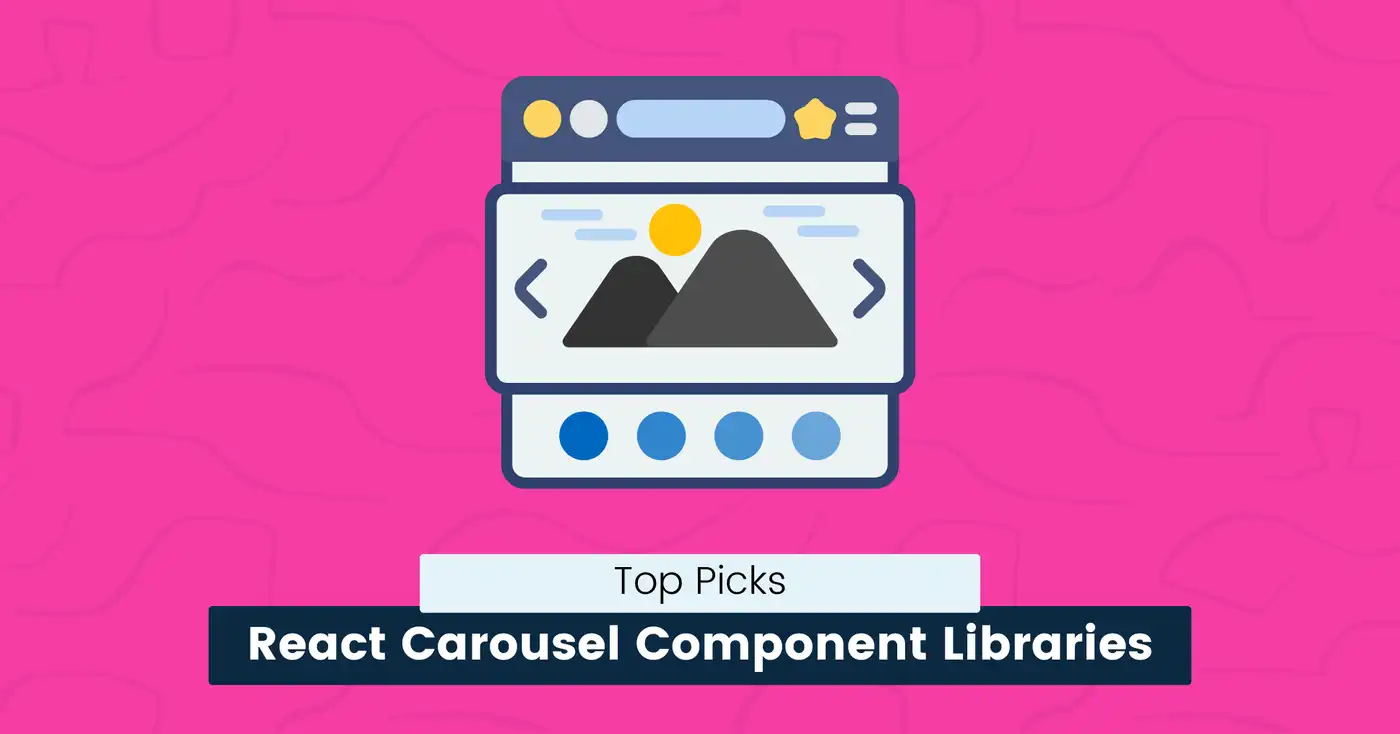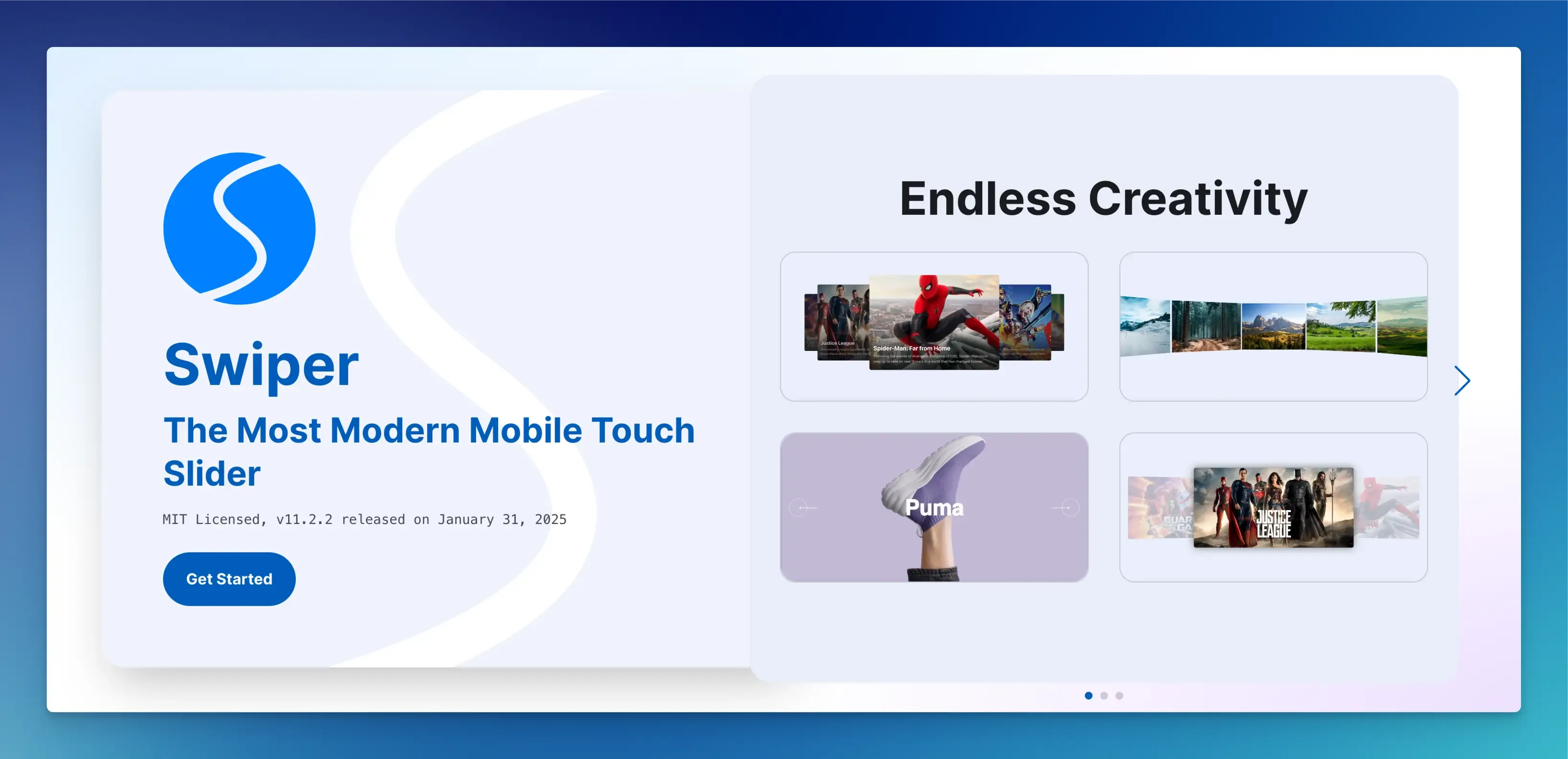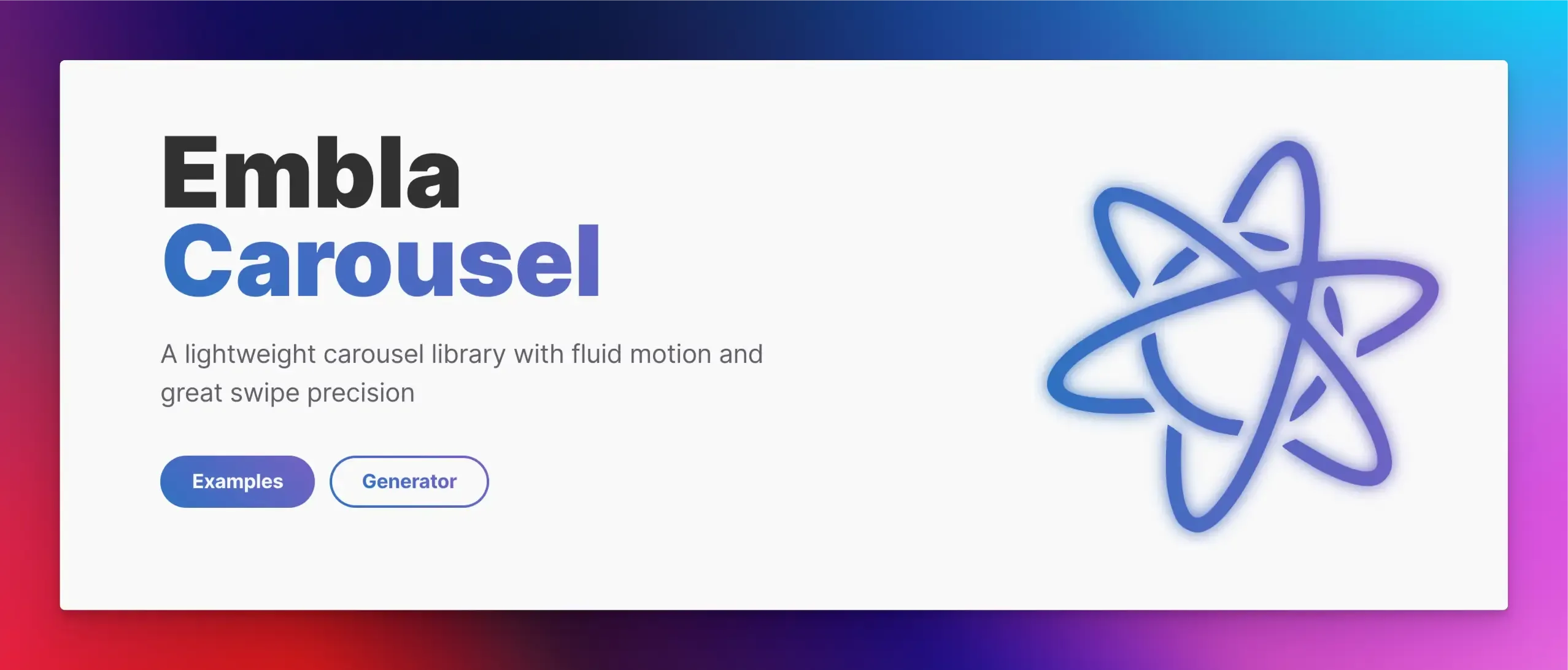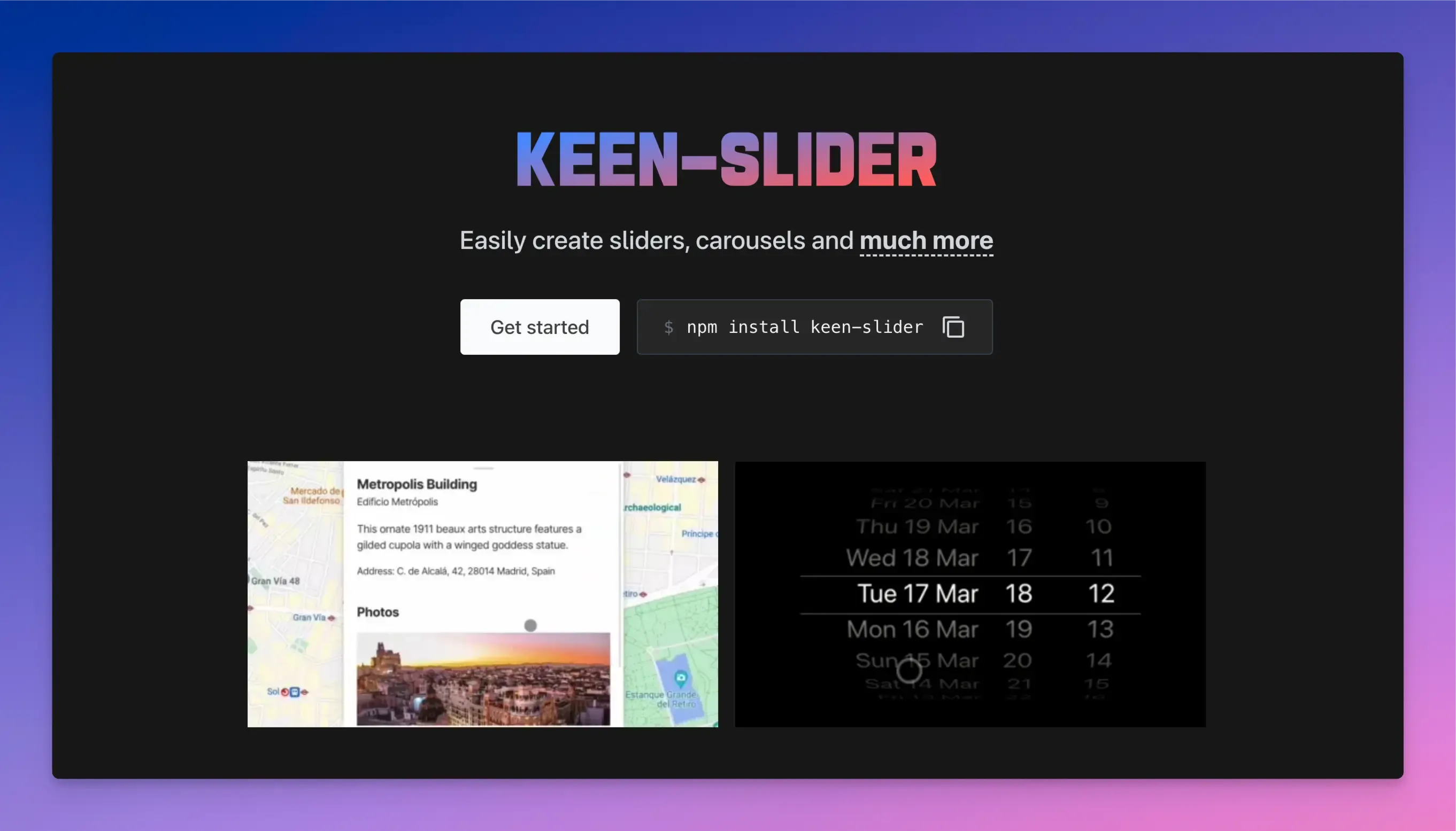
9 Best React Carousel Component Libraries (2025)
React is the most popular front-end technology in the JavaScript tech stack.
It offers pre-built component libraries to create consistent, engaging, visually appealing user experiences.
Among its many UI elements, carousels are essential in modern web development. They allow developers to showcase products or multimedia content through interactive sliders.
However, with so many React carousel libraries available, finding the best one for your project might be difficult.
A poorly chosen carousel might slow down your website and leave a negative impression on your visitors.
So how do you choose the right one?
We’ve done the hard work for you by comparing the top React component libraries based on their features, performance, and ease of use so you can quickly find the right one.
Let’s get started.
What are Carousels and Why You Should Use Them?
Carousels are interactive UI components that display content such as images, cards, or multimedia via arrows, dots, or swipe gestures.
They act as dynamic containers for showcasing multiple items without cluttering the layout.
In React development, carousels are implemented using pre-built libraries that allow developers to easily design responsive and interactive carousels.
There are several benefits of using React carousels:
- Space Efficiency: Carousels stack content horizontally or vertically to maximize limited screen space, making them ideal for content-heavy interfaces.
- User Engagement: They make browsing content interactive and draw attention to featured products, testimonials, or promotions, keeping users engaged.
- Enhanced Mobile UX: A well-optimized carousel supports touch gestures, enabling smooth navigation on mobile devices.
- Responsive Design: They make adapting content hierarchies across different devices easier and emphasize mobile-first CTAs on smaller screens.
- Performance Optimization: Modern carousels support lazy loading, which reduces initial page load times by delaying offscreen components.
- Customization: You can use props to specify autoplay, breakpoints, and smooth transitions without having to write CSS rules.
snappify will help you to create
stunning presentations and videos.
Use Cases of React Carousels in Modern Development
Carousels have wide applications in web design and development. Such as:
- E-commerce: Rotating product images, sales banners, promotions, or trending items.
- Portfolios: Displaying artwork, photography, or project showcases.
- Galleries: Image slideshows for design studios, photographers, or agencies.
- News and Blogs: Featured articles, videos, or podcasts.
- Dashboards: Presenting user analytics or data trends for analytics platforms.
- Landing Pages: Hero sections with sliding testimonials or key features.
Top 9 React Carousel Component Libraries
Here are the best React carousel libraries you should try:
React Slick
React Slick is a highly customizable carousel library offering a range of responsive slider features.
It is simple to set up and lets you create carousels with minimal code.
Since it’s built on top of Slick, it inherits many features while providing a React-friendly API, making it a reliable choice for developers who want a familiar solution without any complexities.
Key Features:
- Responsive breakpoints and autoplay to adjust slides based on screen size.
- Easy integration with server-side rendering (SSR).
- Supports slide, fade, and lazy-loading effects.
- Built-in navigation, including next/prev buttons, dots, and arrows.
- Multiple item display and infinite scrolling.
- Used by over 522k developers.
- 11.8k GitHub stars.
When to Use It:
- You need a basic slider and don’t care about bundle size.
- Working with legacy projects that already use jQuery Slick.
- You want a quick solution without advanced features like 3D transitions or gesture controls.
Swiper

Swiper (implemented as a React wrapper) is a lightweight, high-performance carousel library known for its flexibility and touch-friendly features.
It is open source, supports various types of content, and offers smooth navigation, making it an excellent choice for mobile-friendly websites and modern React apps.
Key Features:
- Touch gestures and keyboard navigation.
- Parallax effects, 3D transitions, and image lazy loading.
- Modular architecture keeps your app lightweight.
- Responsive carousel with multi-row slide layout.
- Supports horizontal and vertical scrolling.
- Built-in pagination, autoplay, RTL support, and breakpoint customization.
- SEO-friendly with image alt tags and ARIA labels.
- Used by over 714k developers.
- 40.4k GitHub stars.
When to Use it:
- Great for mobile web apps and mobile native/hybrid apps.
- You need extensive customization options without extra libraries.
- Product showcases where users swipe through multiple images quickly.
Embla Carousel

Embla carousel is a lightweight, dependency-free carousel focused on performance and extensibility.
It provides the logic (like mobile swipe gestures and snap points) but lets you design the visuals, giving you complete freedom over customization.
Key Features:
- Fully customizable carousel component.
- Smooth scrolling with momentum-based dragging.
- Supports parallax, lazy loading, autoplay, and infinite loops.
- Works with screen readers and keyboards out of the box.
- Lightweight and framework-agnostic core.
- TypeScript-first and accessibility-ready.
- Used by over 131k developers.
- 6.6k GitHub stars.
When to Use it:
- Perfect for projects where branding matters (luxury sites, creative portfolios).
- Mobile-first interfaces that do not compromise on speed.
- You don’t want useless features in your code (such as 3D cube transitions).
- Progressive web apps or performance critical applications.
React Responsive Carousel
React Responsive Carousel is a simple and responsive library that provides built-in styles that are out of the box, allowing developers to customize it as needed. It’s a good option if you need a functional slider without spending time on customization.
Key Features:
- Pre-styled components that are responsive by default.
- Auto-centering, infinite loop, and thumbnails.
- Works well on both mobile and desktop devices.
- Customizable navigation controls.
- Lightweight with minimal dependencies.
- Used by over 162k developers.
- 2.7k GitHub stars.
When to Use it:
- Best for basic image sliders, testimonials, or blogs.
- Projects where WCAG 2.1 compliance is legally required.
- You need something quick and easy without writing custom styles.
React Alice Carousel
React Alice Carousel is a lightweight, beginner-friendly library designed for smooth animations and easy integration. Unlike basic sliders, it focuses on fluid transitions and touch-friendly interactions, making it an ideal choice for modern web applications.
Key Features:
- Built-in fade and slide transitions.
- Auto-play, infinite loop, and keyboard navigation support.
- Customizable animation easing and durations.
- Server-side rendering support.
- Renders non-image components (buttons, videos, cards) as slides.
- Written in TypeScript, so autocomplete and type safety work out of the box.
- 849 GitHub stars.
When to Use it:
- Image galleries, portfolios, and e-commerce sites where smooth scrolling and image presentation matter.
- You need an MVP or prototype for a fast demo.
- Perfect for small teams with limited budgets.
Pure React Carousel
Pure React Carousel is an unstyled React carousel library for developers who want complete flexibility and control over their design.
Unlike pre-styled carousels, it does not impose any default styles, giving you a blank canvas to create your unique carousel with the desired styling.
Key Features:
- Headless, fully controlled, and dependencies-free.
- Supports keyboard navigation and screen readers.
- You can build custom navigation, indicators, and slide layouts.
- SSR-friendly and works with frameworks like Next.js.
- Supports grids and multiple content items per slide.
- Works smoothly across mobile and modern web browsers.
- Used by over 13.2k developers.
- 1.7k GitHub stars.
When to Use it:
- Best for React projects that need pixel-perfect UI control.
- You want to build custom carousels from scratch.
- You need an accessible, responsive, and fully customizable carousel with no design restrictions.
Keen Slider

Keen Slider is a modern, touch-enabled JavaScript slider that works with React and other frameworks.
It doesn’t come with predefined styles or UI elements, giving you full control over appearance and behavior.
Key Features:
- Native React hooks API for smooth state management.
- Snap points, vertical mode, and free-scroll.
- Built-in support for parallax and drag functionality.
- Virtual slides to keep things fast.
- Supports multi-touch and keyboard navigation.
- Optimized for React 18+ and TypeScript.
- Used by over 23.3k developers.
- 4.8k GitHub stars.
When to Use it:
- Easily create sliders for interactive dashboards and mobile-first apps.
- Performance-critical apps that require simple yet powerful sliders.
- You want an open-source carousel without extra dependencies.
Flickity
Flickity is another ****touch-friendly carousel library that focuses on smooth physics-based scrolling, making it a flexible option for different projects.
Key Features:
- Momentum-based scrolling to make interactions feel smooth.
- Drag and flick feature, lazy loading, and wrap-around scrolling.
- Supports slideshow components, galleries, and scrolling lists.
- Allows custom positioning of slides (center, left, right).
- Adaptive height adjustment based on slide content.
- Used by over 14.1k developers.
- 7.6k GitHub stars.
When to Use it:
- You want a mobile-like scrolling experience.
- Perfect for image galleries, card-based layouts, and horizontal scrolling sections.
fullPage.js
fullPage.js is a powerful full-screen carousel library that lets you build entire pages with vertical and horizontal slides simultaneously. It is ideal for storytelling and visually rich websites.
Key Features:
- Full-screen scrolling with section splitting.
- Lazy loading, touch, and mouse wheel support.
- Responsive design with no dependencies.
- Built-in navigation dots and anchors.
- Available extensions for added features and effects.
- Compatible with all modern browsers.
- Used by over 12.1k developers.
- 35.4k GitHub stars.
When to Use it:
- Full-screen scrolling websites or single-page applications.
- Perfect for landing pages, product showcases, and interactive portfolios.
- Building slideshows, step-by-step guides, or immersive user experiences.
snappify will help you to create
stunning presentations and videos.
Other Popular React Carousel Libraries
Here are some other noteworthy React carousel libraries you can check out:
- Nuka Carousel
- React Owl Carousel
- React ID Swiper
- React Swipeable
- Splide.js (React integration)
- Glide.js (React Wrapper)
Final Words
Each React carousel component library listed above offers unique strengths and features that meet your needs.
From lightweight, mobile-first sliders to feature-rich options with touch gestures and SEO-friendly designs, this guide will make it easier to pick one that works well for your next project.
FAQs:
Which React carousel library is best for complete beginners?
If you are a beginner, try React Responsive Carousel. Setting up and implementing carousel functionality is easy, with built-in navigation and styling.
How to choose the perfect React carousel for my project?
When selecting the most suitable carousel component, consider factors such as performance, customization, and responsiveness. If you want simplicity, go for React Responsive Carousel, Swiper for feature-rich sliders, Embla for full control, and Keen Slider for high performance.
